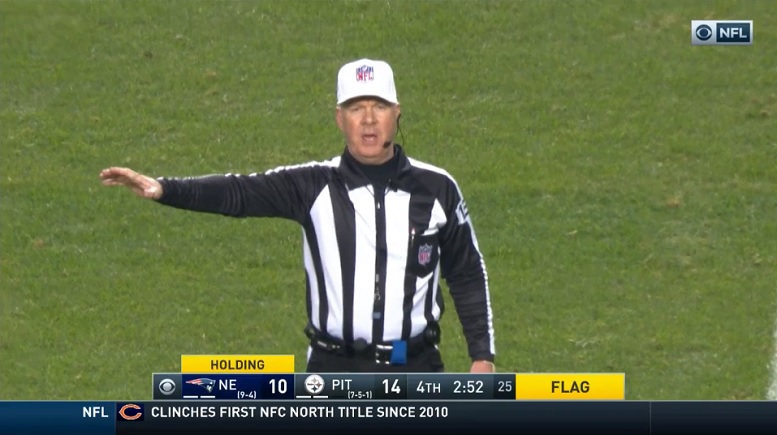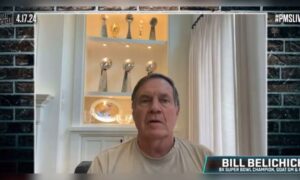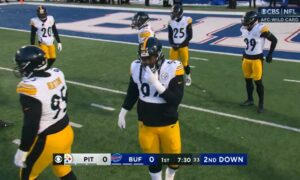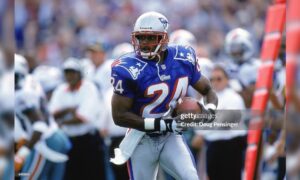On Monday, I received an email from a reader questioning the reasoning for a clock stoppage late in the fourth quarter of the Pittsburgh Steelers game against the New England Patriots and specifically after a 15-yard run by running back Jaylen Samuels. I have now had some time to research that play and questionable clock stoppage and figured I would pass along my findings in a post in case several others were interested.
With 2:58 left in the fourth quarter of Sunday’s game, Samuels ran off left tackle for 15 yards to the Patriots 39-yard-line and he was tackled inbounds by New England defensive back Jason McCourty. The game clock was then stopped at 2:52, however, due to a penalty flag on the field. That penalty was on Patriots defensive tackle Malcom Brown for holding Steelers center Maurkice Pouncey on the play. After the penalty was assessed, the game clock did not start again until the Steelers snapped the football on the next play, which ultimately was a short run by running back Stevan Ridley.
So, why did the Patriots essentially receive a free timeout at the cost of just five extra yards? According to the NFL rulebook, the game clock does not get restarted after a penalty is either accepted or declined inside the last five minutes of the second half. This rule can be found in Section 3, Article 2 and have included that section in the rulebook for all to read below.
SECTION 3: STARTING THE GAME CLOCK
ARTICLE 2. SCRIMMAGE DOWN. Following any timeout (3-37-1), the game clock shall be started on a scrimmage down when the ball is next snapped, except in the following situations:
(a) Whenever a runner goes out of bounds on a play from scrimmage, the game clock is started when an official spots the ball at the inbounds spot, and the Referee gives the signal to start the game clock, except that the clock will start on the snap:
(1) after a change of possession;
(2) after the two-minute warning of the first half; or
(3) inside the last five minutes of the second half.
(b) If there is an injury timeout prior to the two-minute warning, the game clock is started as if the injury timeout had not occurred.
(c) If there is an excess team timeout after the two-minute warning, the game clock is started as if the excess timeout had not occurred.
(d) If there is a Referee’s timeout, the game clock is started as if the Referee’s timeout had not occurred.
(e) If the game clock is stopped after a down in which there was a foul by either team, following enforcement or declination of a penalty, the game clock will start as if the foul had not occurred, except that the clock will start on the snap if:
(1) the foul occurs after the two-minute warning of the first half;
(2) the foul occurs inside the last five minutes of the second half; or
(3) a specific rule prescribes otherwise.
(f) If a fumble or backward pass by any player goes out of bounds, the game clock starts on the Referee’s signal that a ball has been returned to the field of play.
(g) When there is a 10-second runoff, the game clock starts when the Referee signals that the ball is ready for play.
(h) During the Try, which is an untimed down.
(i) When a specific rule prescribes otherwise.
In short, yes, the Patriots received a free timeout at the cost of just 5 yards and had Brown not committed a penalty, New England would’ve had to use their second timeout after Samuels had been tackled inbounds or then wait until the two-minute warning clock stoppage unless the next play had ended ahead of that for them to use a timeout. In theory, and assuming the Patriots had used their second timeout after Samuels had been tackled at 2:52, and then used their third and final timeout after a short 1st down run by Ridley, the Steelers could have then run again on 2nd down and then run the game clock down to the two-minute warning prior to running their 3rd down play. Essentially, that penalty by Brown probably saved the Patriots roughly 41 seconds of clock time and that’s a lot of extra time for quarterback Tom Brady to have.
It’s worth noting, however, that had the Steelers ultimately decided to run on 3rd and 6 from the Patriots 30-yard-line following the Patriots using their final two timeouts, their field goal attempt by kicker Chris Boswell would not have taken place until after the two-minute warning clock stoppage. Instead, the Steelers decided to throw for the first down on that 3rd and 6 play that started with 2:41 left and after the attempted pass from quarterback Ben Roethlisberger to wide receiver JuJu Smith-Schuster was broken up the clock stopped with 2:34 remaining.
In case you’re still curious as to the reasoning behind this unique clock stoppage inside 5 minutes remaining in the fourth quarter, league spokesman Michael Signora addressed this very topic in response to a question he received from Dan Graziano of ESPN.com a few years ago following a 2015 game between the New York Giants and the Dallas Cowboys:
“Prior to 1985, the game clock started on the snap after all penalty enforcements.
“In order to shorten game time while retaining the number of plays at the historic level of about 155, in ensuing years a number of rules adjustments were made, including the reduction of the play clock from 45 to 40 seconds, while starting the game clock on the ready signal after a player going out of bounds or after certain penalty enforcements.
“Because the end of the first half and the end of the game are particularly exciting parts of games, there was no desire to reduce the number of plays that might occur in those time segments, and the traditional timing rules were retained for the last two minutes of the first half and the last five minutes of the second half. During those periods the game clock starts on the snap after all out of bounds plays and after all penalty enforcements.”








